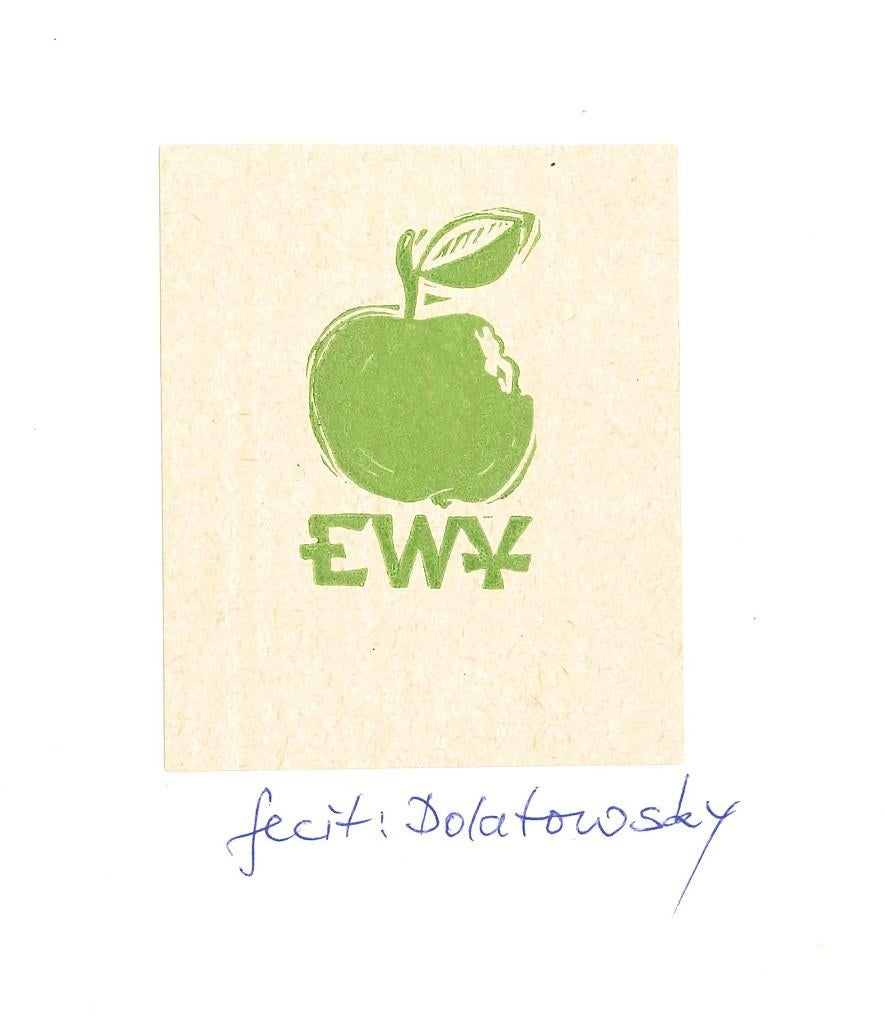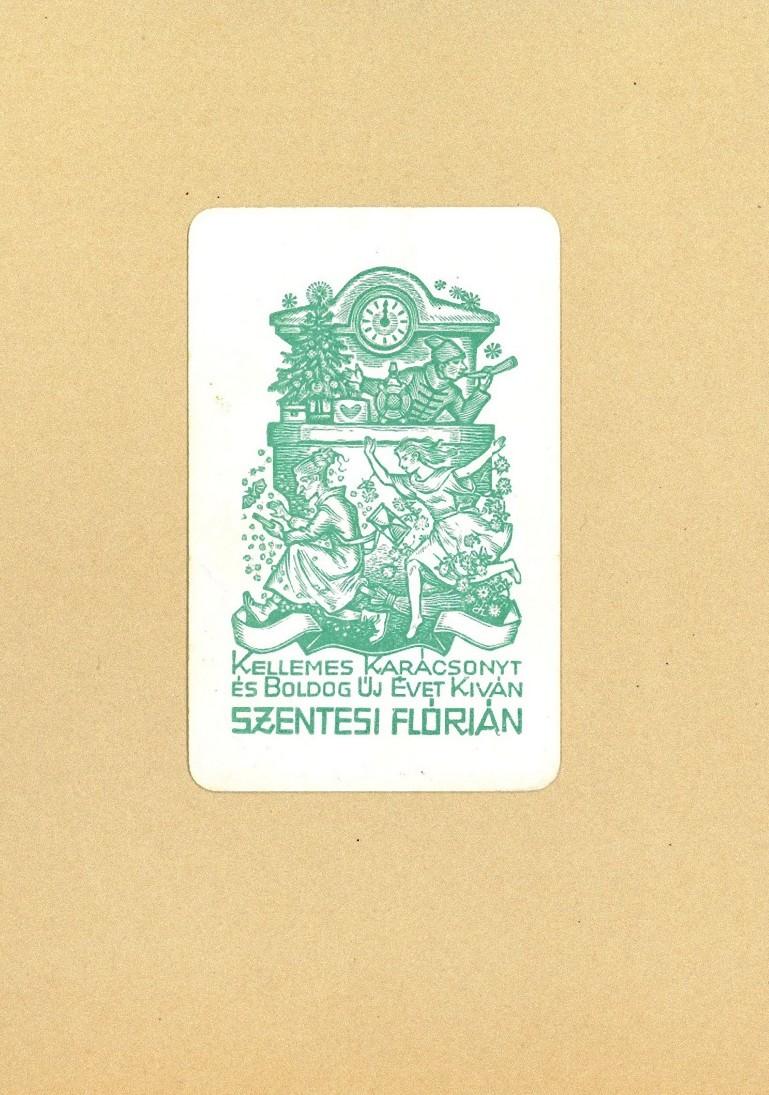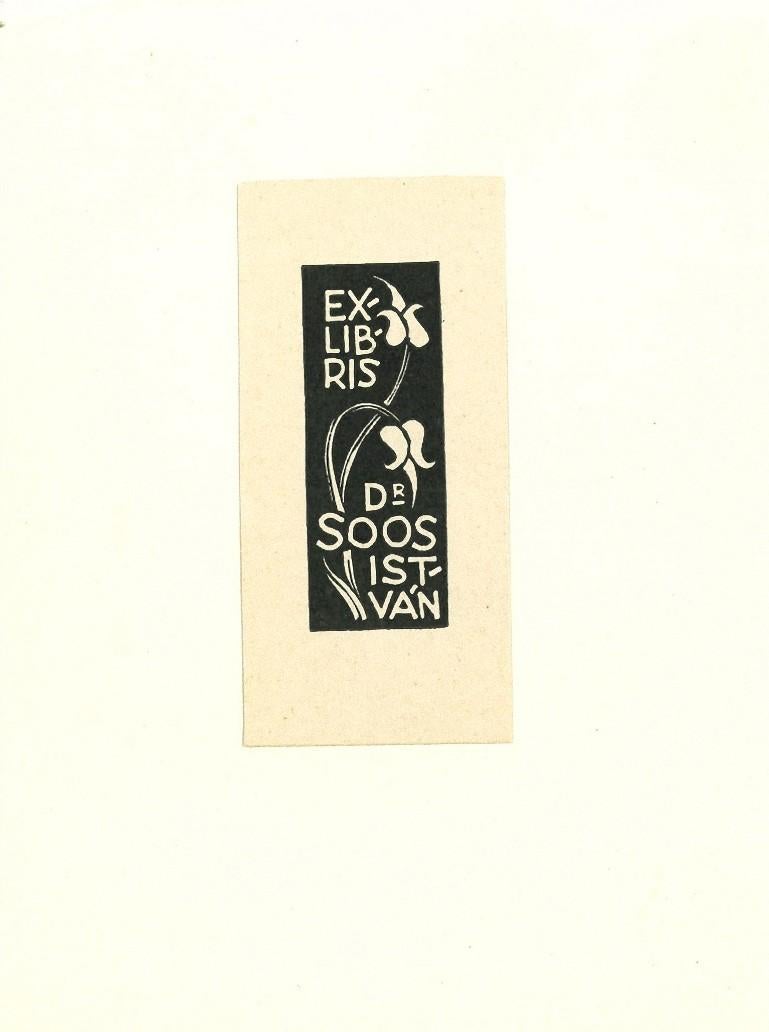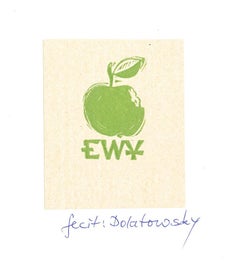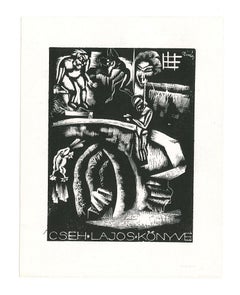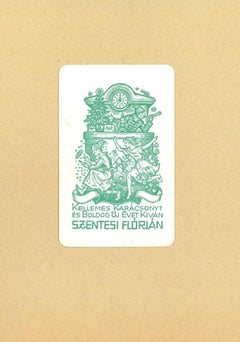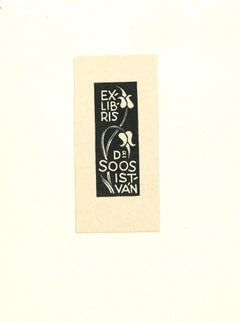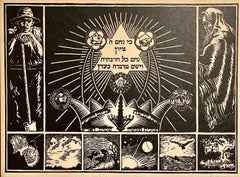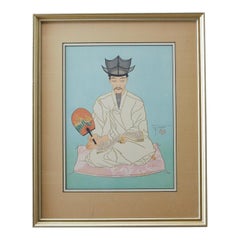Items Similar to Ex Libris Marea - Original Woodcut Print - 1970s
Want more images or videos?
Request additional images or videos from the seller
1 of 2
UnknownEx Libris Marea - Original Woodcut Print - 1970s1970s
1970s
About the Item
Ex Libris Marea is an original Contemporary Artwork realized in the 1970s.
Original B/W woodcut print on ivory-colored paper. Hand-signed by the artist in pencil on the lower right corner.
The work is glued on cardboard.
Total dimensions: 21 x 15 cm.
Mint conditions.
The artwork represents a minimalistic, clean design, a figure behind a shape with a wings on the lower, dreamy-like world, through preciseness and congruous colors.
- Creation Year:1970s
- Dimensions:Height: 3.63 in (9.2 cm)Width: 2.76 in (7 cm)Depth: 0.04 in (1 mm)
- Medium:
- Period:
- Framing:Framing Options Available
- Condition:Insurance may be requested by customers as additional service, contact us for more information.
- Gallery Location:Roma, IT
- Reference Number:Seller: M-1187821stDibs: LU65037998632
About the Seller
4.9
Platinum Seller
Premium sellers with a 4.7+ rating and 24-hour response times
1stDibs seller since 2017
7,496 sales on 1stDibs
Typical response time: 2 hours
- ShippingRetrieving quote...Shipping from: Grasse, France
- Return Policy
Authenticity Guarantee
In the unlikely event there’s an issue with an item’s authenticity, contact us within 1 year for a full refund. DetailsMoney-Back Guarantee
If your item is not as described, is damaged in transit, or does not arrive, contact us within 7 days for a full refund. Details24-Hour Cancellation
You have a 24-hour grace period in which to reconsider your purchase, with no questions asked.Vetted Professional Sellers
Our world-class sellers must adhere to strict standards for service and quality, maintaining the integrity of our listings.Price-Match Guarantee
If you find that a seller listed the same item for a lower price elsewhere, we’ll match it.Trusted Global Delivery
Our best-in-class carrier network provides specialized shipping options worldwide, including custom delivery.More From This Seller
View AllEx Libris Ewy - Original Woodcut Print - 1970s
Located in Roma, IT
Ex Libris Ewy is an original Contemporary Artwork realized in the 1970s
Original woodcut print on ivory-colored paper.
The work is glued on cardboard.
Total dimensions: 21 x 15...
Category
1970s More Prints
Materials
Woodcut
Ex Libris Cseh Lajos Konive - Original Woodcut Print - Early 20th Century
Located in Roma, IT
Ex Libris Cseh Lajos Konive is an original Modern Artwork realized in the 20t Century.
Original B/W woodcut print on ivory-colored paper.
The work is glued on cardboard.
Total ...
Category
Early 20th Century Symbolist More Prints
Materials
Woodcut
Ex Libris Kellemis - Original Woodcut Print - Mid-20th Century
Located in Roma, IT
Ex Libris Kellemis is an original Contemporary Artwork realized in the mid-20th Century.
Original Colored woodcut on ivory-colored paper. An inscription is present on the lower mar...
Category
Early 20th Century More Prints
Materials
Woodcut
Ex Libris Dr. Soos Istvan - Original Woodcut Print - Mid-20th Century
Located in Roma, IT
Ex Libris Dr. Soos Istvan is an original Contemporary Artwork realized in the half of the 20th Century.
Original B/W woodcut on ivory-colored paper.
The work is glued on cardboa...
Category
Mid-20th Century More Prints
Materials
Woodcut
Ex Libris Dr. Lustig - Original Woodcut Print - 1935
Located in Roma, IT
Ex Libris Dr. Lustig is an original Modern Artwork realized in 1935.
Original B/W Xilograph Artwork on ivory-colored paper.
Hand-signed and dated in pencil on the lower right cor...
Category
1930s Modern More Prints
Materials
Woodcut
Ex Libris Gabor Denes - Original Woodcut Print - Mid-20th Century
Located in Roma, IT
Ex Libris Gabor Denes is an original Contemporary Artwork realized in the Mid-20th Century
Original B/W woodcut print on ivory-colored paper. Hand-signed by the artist in pencil on ...
Category
Mid-20th Century Modern More Prints
Materials
Woodcut
You May Also Like
Quaint Snowy Cabin Woodcut by Tim Engelland
Located in New York, NY
Tim Engelland (American, 1950-2012)
Snowy Night - Hitchcock, 1993
Woodcut
8 1/2 x 9 in.
Titled, numbered, signed, and dated bottom: A/Proof, "Snowy Nigh...
Category
1990s Contemporary More Prints
Materials
Woodcut
Norman Rockwell-Style Woodcut by Tim Engelland
Located in New York, NY
Tim Engelland (American, 1950-2012)
Yes Sir, 1994
Woodcut
11 3/4 x 8 3/4 in.
Titled, dated, and numbered bottom: Yes Sir... 60/100, 1994
Signed top: T. ...
Category
1990s Modern More Prints
Materials
Woodcut
Rare 1922 German Jewish Judaica Zion Woodcut Woodblock Print Hermann Fechenbach
By Hermann Israel Fechenbach
Located in Surfside, FL
Title: Zion
Subject: Various biblical images depicting Creation and prayer
1922
Medium: woodcut
Frame: 14" x 18"
Image: 12.5" x 16.75"
Provenance: owned and signed verso by Peter Keil.
Central panel shows the Jewish star over a crown, with inscription in Hebrew: "When God comforts Zion, He will comfort all its ruins and make its deserts look like Eden," and "You have sanctified the seventh day, the goal of creation of Heaven and Earth." This is flanked by a Palestinian farmer pioneer on the left and a Jew praying on the right. The lower tier shows six vignettes of the days of creation from Genesis.
Hermann Fechenbach was born in 1897 in Württemberg, Germany. He grew up in Bad Mergentheim where his parents had an inn, which served as a meeting place for the local Jewish community.
He left school early and through family connections with clothing retailers received training in window dressing. His skill with brush writing was quickly recognised by a big firm in Dortmund where he was responsible for the displays in 10 large windows. He received his conscription papers in 1916 and recalls “being as patriotic as any other fool”. In August 1917 he was involved in a grenade attack in which he was the sole survivor. With serious injuries to both legs he struggled to safety and was eventually transported to a front line “slaughterhouse” where the first of a series of amputations was performed which led to the loss of his left leg.
As a result of his injuries his father dropped his opposition to him becoming an artist. His formal art education started in 1918 with training at a Stuttgart handcraft school for invalids. He attended the Academies in Stuttgart and Munich to learn painting and restoration for 3 years. He was influenced at this time by Max Liebermann. He has been compared to Kathe Kollwitz and was a contemporary of Jakob Steinhardt and hermann Struck. In 1923 he went to Florence for a year. While in Florence he started to produce a series of miniature wood engravings to illustrate the stories of Genesis. This was followed by periods in Pisa, Venice, Vienna and Amsterdam. In 1924 he returned to Stuttgart to paint in the contemporary style “Die Neue Sachlichkeit”. (The New Objectivity was a movement in German art that arose during the 1920s Weimar republic as a reaction against expressionism. The term was coined by Gustav Friedrich Hartlaub, the director of the Kunsthalle in Mannheim, who used it as the title of an art exhibition staged in 1925 to showcase artists who were working in a post-expressionist spirit. These artists—who included Max Beckmann, Otto Dix, George Grosz, Christian Schad, Rudolf Schlichter and Jeanne Mammen) Every spring and autumn he exhibited at the “Kunstgebit” which served as the showcase for all serious artists of the period.
His professional status “Kunstmaler und Grafiker” was recognised by Berlin in 1926. Practically all his work from this period was sold following exhibition.
In 1926 he collaborated with an architect friend to build a bungalow in Hohenheim, a non-Jewish area and a suburb of Stuttgart. Hermann alternately lived in his country bungalow and his town studio, producing portraits for sale or barter and wood engravings for his own pleasure.
In 1930 he married a non-Jewish professional photographer – Greta Batze. They had a studio in Stuttgart, which was used to teach art to a group of 12 students.
In 1933 the Nazi influence removed his name from the official state register together with the right to exhibit. By spending most of his time in his bungalow out of the Jewish quarter the Fechenbachs escaped being registered by the Nazis for some years. They were ostracised and abused by their non-Jewish neighbours. Hermann made weekly visits to friends in town to teach them the practical skills they would need assuming they were to escape from Germany. His energies were directed towards protection and survival.
Ultimately the Nazi persecution forced the Fechenbachs to flee their homeland. They moved to Palestine for 3 months in 1938, but found the political and physical environment unsustainable.
Greta arrived in England penniless in January 1939 to work as a domestic servant and to find a guarantor for her husband. Hermann arrived in May 1939. They moved to Blackheath a few months later. Hermann resumed his painting and engraving as a means of earning a living. He raised enough money to get his parents out of Germany to join his brothers in Argentina but was unable to save his twin sister Rosa who died in a Nazi concentration camp. In 1940 Hermann was interned in Bury as a suspect alien. He protested about his treatment by starting a hunger strike. Because of his persistence he was moved to a prison in Liverpool. From Liverpool he was moved to the Hutchinson Camp in the Isle of Man with fellow artist Kurt Schwitters. Arrangements were made for Greta to be accommodated near by. While interned he commenced work on “Refugee Impressions”, a series of linocut prints (no wood was available).
In 1941 when released from internment the Fechenbachs came under the sponsorship of Dr. Bela Horovitz, the Austrian art publisher who in turn made an introduction to Professor Tancred Borenius.
They were offered lodgings with a family in Oxford. Hermann had his first public exhibition for many years in a small gallery in Oxford in 1942. A second exhibition of oils, pencil drawings, coloured linocut and woodblock prints held later in the year was opened by the mayor of Oxford and critically acclaimed.
In 1944 the first London exhibition took place at the Anglo-Palestinian club in Piccadilly. There were two exhibitions at the Ben Uri Art gallery during this period.
In 1948 a second exhibition at the Anglo Palestinian club was inaugurated by a member of the Rothschild family and several members of Parliament. This was a great success.
In 1944 the Fechenbachs moved to a top floor studio flat in Colet Gardens. Open exhibitions were held each Spring at the Embankment from 1946 to 1951. Movietone News produced a short feature on the artist, which was shown in cinemas in England and Germany.
In 1969 he published the Genesis story in a hard back volume containing 137 prints. He started to research the fate of the entire Jewish community of Bad Mergentheim during the period of the second world war, liaising with historian Dr. Paul Sauer and Professor Max Miller, historian and theologian. In 1972 Kohlhammer published his partly autobiographical book “The last Jews of Mergentheim”. He exhibited at the Anglo-Palestinian Club & the Ben Uri Gallery in the 1940s. His works only came to prominence during the last year of his life when he exhibited at Blond Fine Art.
Peter Keil part of the Junge Wilde. In 1978, the Junge Wilde painting style arose in the German-speaking world in opposition to established avant garde, minimal art and conceptual art. It was linked to the similar Transavanguardia movement in Italy, USA (neo-expressionism) and France (Figuration Libre). They were also known as the Neue Wilde. Artists included; Austria: Siegfried Anzinger, Erwin Bohatsch, Herbert Brandl, Gunter Damisch, Hubert Scheibl, Hubert Schmalix...
Category
1980s Impressionist Figurative Prints
Materials
Woodcut
Le Vieux Manuscrits, Coree-Seoul
By Paul Jacoulet
Located in Rio Vista, CA
Fascinating artwork titled Le Vieux manusrits (old writings Seoul Korea) by Paul Jacoulet. (French-Japanese 1896-1960) finely crafted with lovely graduating background color blue to light green. Depicts a figure seated on a pink pillow wearing a Korean hat...
Category
20th Century Realist Figurative Prints
Materials
Woodcut
United Auto Workers, 1936-1937.
By Antonio Frasconi
Located in New York, NY
Antonio Frasconi created this woodcut and offset lithograph entitled "United Auto Worker, 1936-1937" in 1991. It is signed, titled, dated and inscribed “2/10” in pencil. The paper ...
Category
1990s Contemporary More Prints
Materials
Lithograph, Woodcut
The Key to the Virgin Mary
Located in San Francisco, CA
This artwork titled "The Key to the Virgin Mary" 1975, is an original colors woodcut on thin paper by noted Austrian artist Bernd Kroeber, b.1942. It is hans signed, titled, dated an...
Category
Late 20th Century Surrealist Figurative Prints
Materials
Woodcut
